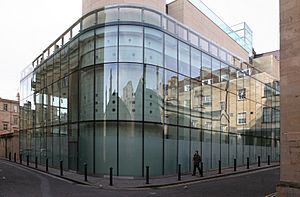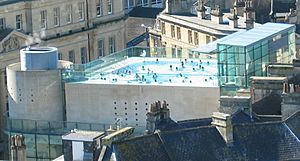Thermae Bath Spa facts for kids
Thermae Bath Spa is a special place in the city of Bath, England. It mixes old spa traditions with a modern building. It first opened its doors in 2006. The local council, Bath and North East Somerset, owns the buildings. They are also in charge of the natural spring waters, which are the only hot, mineral-rich waters in the UK! A company called YTL Hotels runs the Spa.
The main building, called the New Royal Bath, was designed by Grimshaw Architects. It's made from local Bath stone and has a cool glass outside. Inside, you'll find two natural hot pools, including an amazing open-air pool on the roof! There's also an indoor pool. The Spa has a big "Wellness Suite" with steam rooms, an Ice Chamber, and even a special relaxation room. You can also find a cafe, more relaxation spots, and 27 rooms for spa treatments. One of these is the old 18th-century Hot Bath, where you can get special water massages. There's also a separate building called the Cross Bath, which is a historic Georgian building with its own outdoor hot pool.
The Story of Bath's Hot Springs
One of the most famous things about Bath has always been its hot spring water. These springs are the warmest natural hot springs found anywhere in the UK! Long ago, these warm, mineral-rich waters flowed into the Roman Baths. This made Bath a very important city during the Roman period. Later, in the 1700s and 1800s, Bath became a top health resort in the country because of these waters.
Why the Old Pools Closed
In the middle of the 1900s, the city's swimming pool used water directly from the King's Spring. But in 1978, something important happened. Scientists found a tiny organism in one part of the water source. Because of this, bathing in the old public hot pools was stopped to keep everyone safe. For 28 years, people couldn't swim in Bath's famous hot waters.
Thermae Bath Spa Today
Finally, on August 7, 2006, Thermae Bath Spa opened to the public! This meant that after almost three decades, people could once again enjoy bathing in Bath's natural hot springs.
The main part of the spa is in a new building, often called the 'Glass Cube'. It was designed by Sir Nicholas Grimshaw. This modern building is connected to older, historic Georgian spa buildings nearby, like the Hot and Cross Baths. The new design looks very modern, which is a big contrast to the old Georgian buildings around it. Inside, you'll find both traditional and new spa facilities.
In 2014, a study showed that Thermae Bath Spa brings many visitors to Bath. It attracts about 260,000 extra people each year! These visitors also help Bath's economy by spending an extra £15 million a year.



